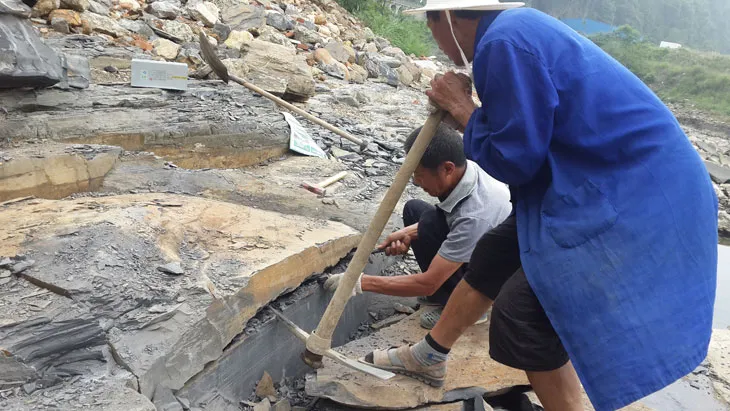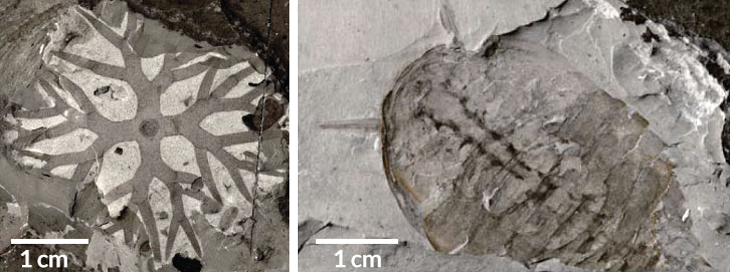Newfound fossils in China highlight a dizzying diversity of Cambrian life
Half of these amazingly well-preserved kinds of creatures have never been seen before

ANCIENT IMPRINTS The newly described Qingjiang biota, a rich fossil site dating to about 518 million years ago, helps document a rapid flourishing of diverse invertebrate life known as the Cambrian explosion. The fossils include abundant jellyfish (left) and comb jellies (middle), as well as a segmented, spiny animal that may be a kinorhynch (right).
D. Fu et al/Science 2019
- More than 2 years ago
Along the banks of China’s Danshui River lies a treasure trove of fossils that may rival the most famous Cambrian fossil assemblage of all, Canada’s Burgess Shale. The roughly 518-million-year-old site contains a dizzying abundance of beautifully preserved weird and wonderful life-forms, from jellyfish and comb jellies to arthropods and algae.
So far, researchers led by paleontologist Dongjing Fu of Northwest University in Xian, China, have collected 4,351 specimens at the new site, representing 101 different taxa, or groups of organisms. Of those taxa, about 53 percent have never before been observed, Fu and her colleagues report in the March 22 Science — not even at other well-known Cambrian fossil sites such as the 508-million-year-old Burgess Shale or a 518-million-year-old site known as Chengjiang, also in China.
“It’s an exciting discovery,” says Jean-Bernard Caron, a paleontologist at the Royal Ontario Museum in Toronto who wasn’t involved in the study. During the Cambrian Period, which began about 542 million years ago, life diversified extremely rapidly. So many new forms appeared in such a relatively short period of time that this diversification is known as the Cambrian explosion. The find “shows that there’s hope for new discoveries” of other Cambrian fossil sites, he says.

Such sites represent snapshots of life long ago, and no one site can portray the true diversity of life on Earth at any given time, Caron says. “It’s a giant jigsaw puzzle, and we only have a few pieces…. But the more pieces we have, the better chance we have to understand life during that time.”
The new fossil trove, called the Qingjiang biota, was first spotted in 2007, says coauthor Xingliang Zhang, a paleontologist also at Northwest University. “I have been working on Burgess Shale–type fossils for many years, and know what kind of rocks preserve [them],” Zhang says.
During a field expedition that year, he and his students were investigating a different rock layer dating to the Cambrian. At lunchtime, he says, he happened to sit on the next lower layer of rocks as it was being lapped by the river’s water — and immediately recognized that the fine clay layer was the perfect preservation setting for fossils. “We split the clay stone and I found a Leanchoilia [a kind of segmented arthropod] quickly.” Many more discoveries soon followed.
The site is remarkable for the quality of the preservation of the animals, says Allison Daley, a paleontologist at the University of Lausanne in Switzerland who was not involved in the new study but wrote a commentary that accompanies it in Science. “There was very little metamorphism or weathering effect, which does affect some other [Cambrian fossil] sites, like Burgess or Chengjiang. We see almost pristine fossils at this site.” She mentions one startlingly clear image of a jellyfish. “I mean, if you were going to smack a jellyfish on a rock, that’s how it would look.”
Weird wonders
The excellent preservation of the Qingjiang fossils reveals fine morphological details of some of the life-forms that lived in Cambrian seas, such as a branched alga (left) and the segmented body of an arthropod called a megacherian (right).

Unlike other Cambrian fossil troves, the Qingjiang biota appears to contain a high proportion of jellyfish, or cnidarians, and comb jellies, also called ctenophores. These species, particularly the comb jellies, are extremely rare at other sites.
With so many ctenophore fossils preserved so well, Daley says, studying their shapes may help to answer a long-standing debate: Whether comb jellies or sponges are the most primitive animal on their family tree. Scientists have thought that sponges appear closer to the base of the tree, based on their very simple shapes. But some molecular analyses have hinted that comb jellies may be at the base of the tree.
“It’s hard to disentangle the exact relationships of these [creatures],” Daley says. “These early branching groups diverged from each other such a long time ago…. So getting more info on [them] at this new site, where the preservation is really amazing, is really going to fill a gap.”
The Burgess Shale, a vast deposit of fossil-bearing rocks in the Canadian Rockies, was discovered in 1909. It was this site that first gave scientists a glimpse into the Cambrian explosion, the rapid diversification of life that occurred during that period. The Burgess and Chengjiang sites, separated by 10 million years and half a world today, share only about 15 percent of the same taxa.
That might be expected, Daley says, given their differences in both space and time. But the Qingjiang and Chengjiang sites, which date to the same time period and are separated by only 1,050 kilometers today, share only 8 percent of their taxa, she says. The researchers, however, suggest that the Qingjiang site may have been a slightly deeper marine environment. If so, that difference in ancient environment may have been the reason why the assemblage of creatures is so different, Daley says.
The new work is preliminary, representing just the first of what is likely to be a deluge of studies describing fossils found at the site, Zhang says. “We’re just beginning!”
Even after 110 years of digging in the Burgess Shale region, paleontologists are still turning up rich new sites and bizarre new creatures, adds Caron, of Canada’s Royal Ontario Museum. Just last summer, he and colleagues made new discoveries, including an enigmatic shield-shaped critter that he dubbed “the mothership.”







